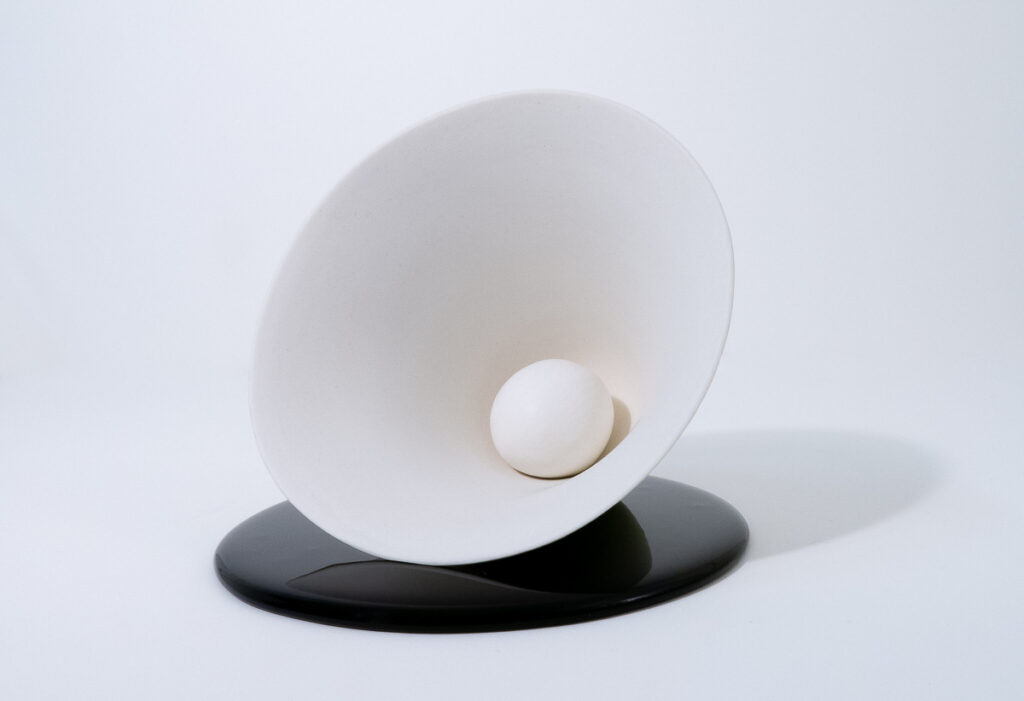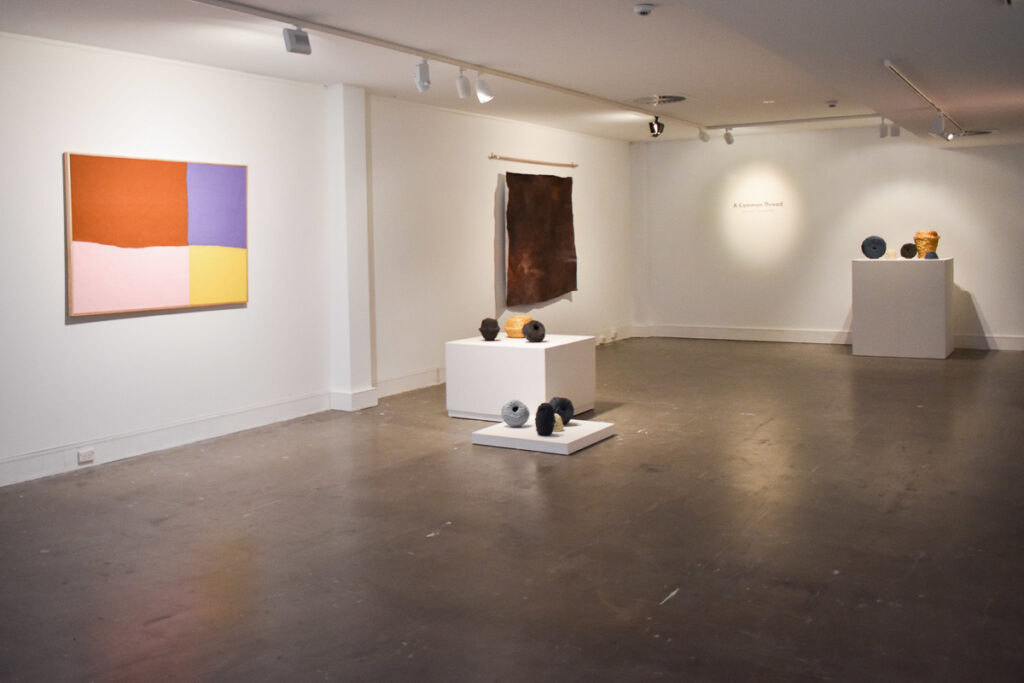- Robyn Campbell, Blaze, 2020. Photo: courtesy of the artist.
- Robyn Campbell, Lilt, 2020. Photo: courtesy of the artist.
- Jo Victoria, Ocean series, 2020. Porcelain and glass. Photo: Brenton McGeachie
Julie Bartholomew writes about two exhibitions that reveal the mysteries of making.
Transference: Works by Jo Victoria and Robyn Campbell
Integrating glass and porcelain is a passionate focus of my art practice, so writing about two artists who are exploring these exquisite materials, each requiring challenging processes of making, is an exciting task. However, discussing art objects that I have not experienced in ‘real’ life and time is unfamiliar, although 2020 is a year for unparalleled experiences. The art world must move forward by expanding its virtual engagement so artists, writers, galleries and their audiences remain connected, enabling forms of physical distancing to reboot our lives. Fortunately, I have walked around, touched and engaged with Jo Victoria and Robyn Campbell’s earlier work during exhibitions and studio visits. Memories of haptic body and object interactions—gliding fingers across clay surfaces and soaking up the three dimensionalities of an object whilst sharing the same space – seem more crucial now than ever before.
The exhibition titled Transference—the action of transferring something—encapsulates Victoria and Campbell’s shared enthusiasm for light in action. Both artists engage with porcelain and glass forms to activate reflections, shadows, glints, shimmers, flickers and transience. Within bodies of porcelain, light animates a soft white translucency, and in bodies of kiln cast and slumped glass, light radiates a crystal-like transparency.
As demonstrated by the artists’earlier work, form is realised in very distinct ways. Victoria deconstructs the solidity of form by allowing light to pierce through fragmented or perforated slip-cast segments and organic burn-outs. Campbell reinforces shape and form by attaining a continuity of surface across planes of porcelain, glass and enclosed structures. For Campbell, this approach encourages reflected light to transit smoothly and quietly across open vessels and enclosed objects that are nestled within.
Sharing an enthusiasm for the natural environment, Victoria’s porcelain forms echo the fragility of disintegrating organic matter or fractured shells found at the edge of oceans. Reflective high gloss glazes and aquamarine kiln slumped glass capture the transitory and fleeting ocean light that is so fundamental to her practice.
Campbell’s glass and porcelain pieces reconfigure patterns and shapes experienced during nature walks, as essential and simple material manifestations. The interplay between open and enclosed organic forms, intensified by fleeting light and shadow, transmits a visual narrative that speaks to protection, shelter, containment, calmness and tranquillity. Pool and Echoin particular visualises the interrelated natural world in a refined and sensuous manner.
Transference is an exhibition that foregrounds the capacity of light to activate inanimate clay and glass forms and suggests the beauty and transience of the natural world. This show presents a collection of stunning pieces and given the opportunity, audiences would marvel at their beauty, strength, vulnerability and obvious dedication to craftmanship. On the other hand, Transference may also allude to the act of sharing material knowledge, skills and different responses to the world of nature. Trained as a glass artist, Robyn Campbell suggests the quiet beauty of landscapes with the interplay of light and relational porcelain and glass forms. Trained as a ceramics artist, Jo Victoria captures and reflects light through the fragility of porcelain and glass forms to advocate for the transcendence of seascapes. Transference is the end result of a collaborative narrative between the artists that encapsulates a passion for porcelain, glass, light and the natural world that they occupy.
A Common Thread: Works by Harriet McKay and Sam Gold
- Sam Gold, Stillness (Votive vessels series), 2020. Photo: samRoberts
Touch and haptic are fundamental aspects of material and process-oriented art practices. Intimacy between bodies and materials during long periods of repetitive physical engagement engenders artwork that is guided by the procurement of material knowledge and processes that activate relational and often cathartic experiences. Sam Gold and Harriet McKay explore these processes of connectedness, a common thread aligning their distinct approaches to making.
Gold draws attention to the labour of hands that manipulate threads of clay. Repetitive movements conjoin body, material and mind to form voluminous structures that lay bare the rhythms of making. McKay’s intensive processes of layering threads of naturally dyed felt, calico and raw canvas, form rich and worn textured surfaces. McKay’s fibrous collages disclose the reiterative hand and material interplay.
Time is fundamental to Gold and McKay’s individual practices because both artists embrace repetitive crafting, as does Adelaide textile artist Sera Waters who refers to her own practice as ‘using time to make time …’ Waters describes a repetitive body and object interaction as opening space for thinking about the world in a different way. Therefore, immersive making may be understood as activating an interconnection between body, material and mind. As philosopher Maurice Merleau-Ponty argues, all our senses are connected, both body and mind are needed to form experience.
From the perspective of the viewer, art objects that reveal enduring acts of making can trigger a prolonged moment of consideration. The duration of the making and the artist’s time is often noticeably apparent, and the viewer reciprocates by spending time with the work as its fullness unfolds.
Gold’s groupings of stoic, bulbous forms emanate a silent strength. The viewer is able to glimpse inside these vessels, through mostly small openings, that provide access to a hidden, mysterious inner space. For Gold, the vessel’s interior holds significance. Her new series ‘takes inspiration from seeds, what emerges from the internal space, what could grow from within…’. The simplicity of Gold’s forms also allow for a greater consideration of the exquisitely coloured clays, oxides and traces of finger marks imprinted within each coil.
Form and colour are also a strong aspect of McKay’s paintings but in this instance, her reductive, coloured configurations redirect the viewers’ attention to rich and textural layers of naturally dyed felts, calico and raw canvas. Material narratives, their histories and memories are of great importance for McKay. ‘Felt holds resonance to me, the smell reminds me of my grandmas’ house in Adelaide and I cannot move away from the nostalgia it stirs in me—I love the weight of felt, the comfort of the material, and the warmth which it omits’.
In our visually dominant world, the significance of mind, body, material relationships can be easily set aside, particularly during our current Covid-19 crisis, when visual media has become our dominant channel for social connectedness and experiencing art objects. Gold and McKay’s exhibition is a dynamic reminder, a testament to the importance of knowing the world by physically navigating materials and allowing the hand to think through ideas of making.
These two exhibitions are at Craft ACT, 15 May 2020 – 27 June 2020.
Further reading
E Grosz, ‘Merleau-Ponty and Irigaray in the Flesh’, D Olkowski and J Morely (ed), Merleau-Ponty, Interiority and Exteriority, Psychic Life and the World State, 1999, p.147
J Millner, ‘Conceptual Beauty: Perspectives on Australian Contemporary Art’, Artspace Visual Arts Centre Ltd. Sydney, 2010, p.189
Julie Bartholomew is a ceramic artist who in February 2017 was appointed Head of Ceramics Workshop, at the School of Art & Design, Australian National University in Canberra.






